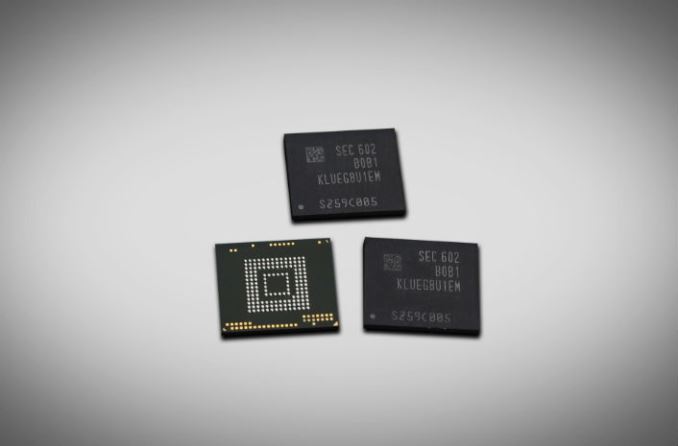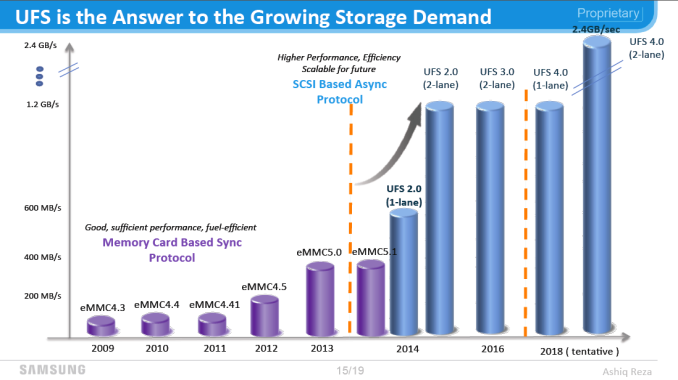Samsung Announces 256GB UFS Embedded Storage Solution
by Joshua Ho on February 25, 2016 6:00 AM EST- Posted in
- Trade Shows
- Samsung
- Mobile
- UFS
- MWC 2016

Interestingly enough, we’re seeing something of a division in the mobile storage space, as it seems that some OEMs are focusing their efforts on UFS for internal storage, while others are moving towards NVMe over mobile PCI-E. Samsung Electronics seems to be staying with UFS for now, and recently announced their next generation of UFS 2.0 embedded storage solutions, which use 3D V-NAND to enable better NAND storage characteristics and to bump up the capacity from 128GB to 256GB.
By moving to V-NAND, random reads and writes are now at 45k and 40k IOPS, or 176 and 156 MB/s with 4KB blocks, which is well over double what shipped in the Galaxy S6. For sequential reads, speeds top out as high as 850 MB/s which is even faster than the 520 MB/s maximum of some SATA SSDs. Given that this is likely to be Samsung’s 30nm V-NAND process, I suspect that the storage density needed to achieve this kind of performance involves some sort of SLC/TLC hybrid, but in the absence of more information it’s hard to say.
While the new NAND definitely is part of the speed improvement, it couldn't have been achieved without an increase of the interface bandwidth. The new memory today is the first announced UFS 2.0 solution based on a 2-lane interface. The UFS 2.0 standard defines a lane running at up to HS Gear 3 at up to 600MB/s, so doubling up of the lanes gives a theoretical maximum of 1.2GB/s. It’ll definitely be interesting to see what devices adopt this storage solution in the near future.
Source: Samsung Newsroom











23 Comments
View All Comments
ddriver - Thursday, February 25, 2016 - link
More like "some" (high end) phones in 2016 will have a faster interface than the now 8 years old SATA3 interface.Oddly enough, there are still no SATA-Express SSDs on the market, I'd love a couple of 2TB EVOs at 1.8 GB/sec bandwidth, but for some reason nobody makes SATA-E SSDs, only SATA and PCI-E.
Ryan Smith - Thursday, February 25, 2016 - link
SATA-Express is essentially dead. What you'll eventually see is U.2, which allows for 4 PCIe lanes instead of 2.http://www.anandtech.com/show/9363/sff8639-connect...
ddriver - Thursday, February 25, 2016 - link
Without a single available product (if we don't count that butty enclosure) it is more than dead - it is practically stillborn.Still, the industry continues manufacturing SSDs capped by SATA rather than adopting U.2.
cyrand - Thursday, February 25, 2016 - link
Intel have a consumer U.2 product the 750 pro. It comes as both a add in car or U.2.Kristian Vättö - Thursday, February 25, 2016 - link
Switching to PCIe, especially NVMe, requires major parts of the controller and firmware to be architected. Every single SSD manufacturer is working on PCIe drives and we should start to see plenty shipping this year.Poik - Thursday, February 25, 2016 - link
Okay so Samsung has 256GB mobile memory now yet most phone shipping still have less than 64GB. While I applaud Samsung for doing this when most phones have 32GB or less (including Samsung's very own new flagship device) I feel like there's a complete disconnect. SD cards are great for photos and files you move around. A 128GB/256GB phone or tablet would be awesome. Space would no longer be an issue. I guess what I'm asking is there's hardly anything using the current 128GB chips, what's the point of double?saratoga4 - Tuesday, March 1, 2016 - link
Chips are usually announced long before they're available for sale, and available for sale a while before they're actually designed into a new device. 128GB will be used in premium parts this generation, then 256 GB will follow.ragenalien - Thursday, February 25, 2016 - link
Sata Express was the answer to that. It however hasn't been widely accepted and I haven't seen a single device equipped to use it. Some motherboards have it but since there are no devices with it, it's useless.darkich - Thursday, February 25, 2016 - link
..yet don't hold your breath for seeing this on tablets this year.Samsung will stuff it in the Note 6, and proudly update its Android tablet range with a SoC from last year.
bug77 - Thursday, February 25, 2016 - link
And yet, the Galaxy S7 will have 32GB of internal storage. At this point it seems a 64GB variant has very few chances to materialize.